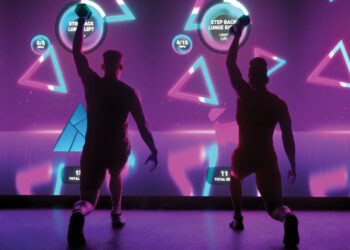Between the many types of clubs found in the fitness industry — boutique, high-value/low-price (HVLP), full service or any other variation — there’s one constant: the need for fitness equipment.
Equipment isn’t just an added commodity — it’s a defining component of your club. So updated and user-friendly equipment that matches your programming is very important.
“Your equipment and the way it is placed on the workout floor should be able to tell your story and be consistent with your brand,” said Shawn MacKinnon, the vice president of operations for GoodLife Fitness. “A complete beginner should be able to navigate the floor layout and get a great workout without feeling intimidated.”
The right equipment can provide major appeal for those beginning exercisers, making your equipment purchasing choices more important than you might realize.
“Bringing new equipment into your club is an essential ingredient in your business success formula,” said Noah Hastay, the operations manager at Gainesville Health & Fitness. “Considering the pace at which technology is evolving each year, having cardio equipment that is more than seven to eight years old can be a dealbreaker for prospective members.”
So when updating your equipment pieces, it’s important to first search the marketplace to find the best match for your members’ needs, facility layout and programming, among other factors.
Choosing Your Brand
With so many choices on the market, it can be difficult to sort out which equipment you should buy. Ease of use, durability and integrated technology are some of the factors to consider.
“Equipment must look good, but more importantly, it must perform,” said MacKinnon. “Ask if the movement is safe, biomechanically correct, motivating and fun. And are the adjustments easy to find and easy to use?”
Machines with awkward movements can be a major turn-off for members, so MacKinnon and his team always look for better options. “We try hard to stay current and test out machines with new movements,” he said.
When buying new equipment, it’s also important to always keep the member experience in mind. “Pay attention to what members have been requesting,” said Hastay. “People want simple. Coming in and working out is hard enough as it is.”
Several aspects of your facility can make or break a prospective member’s experience, and your equipment is no different. “Are the machines well-built, user-friendly and non-intimidating?” asked MacKinnon. “Ideally, we want members to get on and go, so it is important that the equipment helps provide a positive experience.”
Another important variable for equipment purchasing is how well it fits within the facility. “Ask yourself, ‘When placing the equipment, will there be sun glare on cardio screens?’” said Hastay. “Are the power outlets in the proper place for cardio? Do you have proper flooring?”
Other factors to consider are the size of your space, which equipment is most-used, how many new pieces you’ll need, and the complexity of any maintenance and cleaning procedures.
You’re sure to have some questions, and equipment manufacturers are a great resource.
“We like to have someone from the equipment company come to our space to talk about the plan before any purchases happen, as well as to ensure all questions are brought up and details talked through,” said Hastay.
The Partner
Every piece of fitness equipment requires maintenance at some point, no matter how perfect it may seem at first. When issues do arise, you should trust an equipment manufacturer to resolve problems as quickly and painlessly as possible.
“If there is an issue — almost all manufacturers have them — how they respond is crucial,” said MacKinnon. “We are willing to work through issues with a manufacturer if we see the effort and commitment on their end is genuine.”
According to MacKinnon, many performance problems can be preempted by evaluating manufacturers’ previous work. “Look for companies that build high-quality equipment and have a reputation of consistently doing so,” he said. “Determine if their equipment can perform on a large scale and support the quantity we require to outfit a large portfolio of clubs.”
The right manufacturer will make all the difference. It might be tempting to choose equipment with a questionable reputation in an attempt to save money, but choosing a quality company will benefit your brand in the long run.
“It’s important to find a reputable manufacturer who will stand by their product in the form of service and warranties,” said Hastay. “Having a face-to-face relationship with a manufacturer representative is also vitally important.”
In fact, most equipment manufacturers sponsor industry trade shows — giving attendees an opportunity to meet potential partners face-to-face. In addition, this allows you test equipment first-hand.
“Always make an attempt to try out the piece of equipment before buying it,” advised Hastay. “You can try at one of the industry trade shows, like IHRSA.”
What’s Trending?
Whether certain pieces are popular among members or not, it’s important to stay aware of new equipment that offers new movements and features.
“Keep an eye out for unique, game-changing offerings members can’t live without,” said MacKinnon. “It’s always tough to remove certain machines that have been around forever — however, if you replace them with newer, safer and more effective versions, members will eventually get on board with them.”
Both Hastay and MacKinnon are seeing several trends across the industry related to innovative equipment and how it’s being paired with new workouts. “Here are a few trending equipment choices I’ve noticed: glute machines, half racks with sound absorbing platforms, and small group training rigs,” said MacKinnon. “Stepmills have also grown tremendously in popularity.”
At Gainesville Health & Fitness, a constantly evolving trend is cardio pieces. “Currently trending for cardio would be the self-powered treadmills, and both curved and flat air bikes,” said Hastay. “They are big in high intensity interval training (HIIT) spaces.”
According to Hastay, technology will play a big role in the evolution of strength equipment. “I believe the trend is smart equipment,” he said. “eGym and Technogym are leading by way of automating machine and weight settings with radio-frequency identification (RFID), increasing resistance on the eccentric portion of repetition, and adding a gamification feature to get your mind off of the pain in your muscles.”
As far as functional fitness goes, most trends involve the functionality of the area itself.
“I feel a lot of energy is being put into storage solutions, and the ability to fit more equipment into less space and still look nice,” said Hastay. “Design is integral in the industry today, from the layout of your facility down to the way all of your equipment is stored when not in use.”
According to MacKinnon, clubs are using a variety of equipment and designs to cover a wide range of offerings. “Turf training areas with great functional offerings are another popular trend,” he said. “These areas tend to include obstacle course training areas, treadmills with softer deck options, HIIT-specific products, on-demand virtual video classes, and machine usage data tracking.”
One final trend Hastay has observed doesn’t involve specific equipment pieces, but rather the effort of manufacturers to build long-lasting partnerships with clubs.
“A trend across equipment manufacturers is rather than trying to sell you on a single piece of equipment, they are building programming to go with it and implement into small group training,” said Hastay. “Typically, programs and equipment are in eight to 14 units in a room, with a virtual or live instructor, with companies like FreeMotion and PowerPlate, to name a few.”
Equipment purchases are essential to success. New equipment pieces allow you to deliver more exceptional experiences for members, on the open fitness floor and in specialized classes.
“New equipment purchasing can be exciting, but stressful,” said Hastay. “Especially with the number of clubs and studios that are opening up today, having new and properly functioning equipment is more important than ever.”
Stay ahead in the fitness industry with exclusive updates!
Bobby is the former assistant editor of Club Solutions Magazine.










